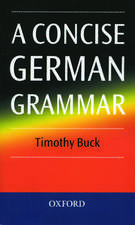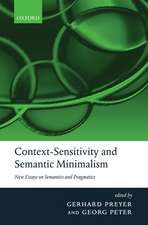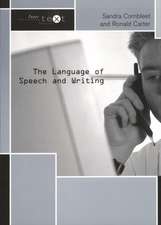True to Form: Rising and Falling Declaratives as Questions in English: Outstanding Dissertations in Linguistics
Autor Christine Gunlogsonen Limba Engleză Paperback – 13 feb 2014
1) It's raining?
2) It's raining.
The difference between (1) and (2) is intonational: (1) has a final rise--indicated by the question mark--while (2) ends with a fall.
Christine Gunlogson's central claim is that the meaning and use of both kinds of sentences must be understood in terms of the meaning of their defining formal elements, namely declarative sentence type and rising versus falling intonation. Gunlogson supports that claim through an investigation of the use of declaratives as questions. On one hand, Gunlogson demonstrates that rising and falling declaratives share an aspect of conventional meaning attributable to their declarative form, distinguishing them both from the corresponding polar interrogative (Is it raining?) and constraining their use as questions. On the other hand, since (1) and (2) constitute a minimal pair, differing only in intonation, systematic differences in character and function between them--in particular, the relative "naturalness" of (1) as a question compared to (2) --must be located in the contrast between the fall and the rise.
To account for these two sets of differences, Gunlogson gives a compositional account of rising and falling declaratives under which declarative form expresses commitment to the propositional content of the declarative. Rising versus falling intonation on declaratives is responsible for attribution of the commitment to the Addressee versus the Speaker, respectively. The result is an inherent contextual "bias" associated with declaratives, which constitutes the crucial point of difference with interrogatives. The compositional analysis is implemented in the framework of context update semantics (Heim 1982 and others), using an articulated version of the Common Ground (Stalnaker 1978) that distinguishes the commitments of the individual discourse participants.
Restrictions on the use of declaratives as questions, as well as differences between rising and falling declaratives as questions, are shown to follow from this account. Gunlogson argues that neither rising nor falling declaratives are inherently questioning--rather, the questioning function of declaratives arises through the interaction of sentence type, intonation, and context.
Din seria Outstanding Dissertations in Linguistics
-
 Preț: 449.41 lei
Preț: 449.41 lei -
 Preț: 436.14 lei
Preț: 436.14 lei -
 Preț: 486.60 lei
Preț: 486.60 lei -
 Preț: 449.41 lei
Preț: 449.41 lei -
 Preț: 493.12 lei
Preț: 493.12 lei -
 Preț: 484.69 lei
Preț: 484.69 lei -
 Preț: 449.41 lei
Preț: 449.41 lei - 18%
 Preț: 997.27 lei
Preț: 997.27 lei -
 Preț: 448.49 lei
Preț: 448.49 lei - 25%
 Preț: 768.30 lei
Preț: 768.30 lei -
 Preț: 483.92 lei
Preț: 483.92 lei -
 Preț: 144.40 lei
Preț: 144.40 lei -
 Preț: 483.63 lei
Preț: 483.63 lei -
 Preț: 449.41 lei
Preț: 449.41 lei -
 Preț: 439.78 lei
Preț: 439.78 lei -
 Preț: 452.69 lei
Preț: 452.69 lei -
 Preț: 324.22 lei
Preț: 324.22 lei -
 Preț: 449.41 lei
Preț: 449.41 lei -
 Preț: 449.41 lei
Preț: 449.41 lei -
 Preț: 483.49 lei
Preț: 483.49 lei -
 Preț: 482.53 lei
Preț: 482.53 lei -
 Preț: 489.26 lei
Preț: 489.26 lei - 18%
 Preț: 999.82 lei
Preț: 999.82 lei -
 Preț: 348.79 lei
Preț: 348.79 lei -
 Preț: 137.27 lei
Preț: 137.27 lei -
 Preț: 482.53 lei
Preț: 482.53 lei - 18%
 Preț: 1012.69 lei
Preț: 1012.69 lei -
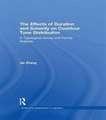 Preț: 449.41 lei
Preț: 449.41 lei -
 Preț: 483.12 lei
Preț: 483.12 lei -
 Preț: 449.41 lei
Preț: 449.41 lei - 18%
 Preț: 2332.09 lei
Preț: 2332.09 lei -
 Preț: 426.55 lei
Preț: 426.55 lei -
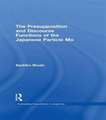 Preț: 449.41 lei
Preț: 449.41 lei - 31%
 Preț: 765.19 lei
Preț: 765.19 lei -
 Preț: 446.58 lei
Preț: 446.58 lei -
 Preț: 215.29 lei
Preț: 215.29 lei -
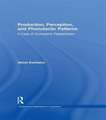 Preț: 449.41 lei
Preț: 449.41 lei - 30%
 Preț: 768.86 lei
Preț: 768.86 lei -
 Preț: 449.41 lei
Preț: 449.41 lei -
 Preț: 449.41 lei
Preț: 449.41 lei - 25%
 Preț: 496.94 lei
Preț: 496.94 lei - 18%
 Preț: 997.14 lei
Preț: 997.14 lei -
 Preț: 490.83 lei
Preț: 490.83 lei
Preț: 489.26 lei
Nou
Puncte Express: 734
Preț estimativ în valută:
93.62€ • 100.11$ • 78.06£
93.62€ • 100.11$ • 78.06£
Carte tipărită la comandă
Livrare economică 18 aprilie-02 mai
Preluare comenzi: 021 569.72.76
Specificații
ISBN-13: 9780415865074
ISBN-10: 0415865077
Pagini: 124
Dimensiuni: 152 x 229 x 7 mm
Greutate: 0.18 kg
Ediția:1
Editura: Taylor & Francis
Colecția Routledge
Seria Outstanding Dissertations in Linguistics
Locul publicării:Oxford, United Kingdom
ISBN-10: 0415865077
Pagini: 124
Dimensiuni: 152 x 229 x 7 mm
Greutate: 0.18 kg
Ediția:1
Editura: Taylor & Francis
Colecția Routledge
Seria Outstanding Dissertations in Linguistics
Locul publicării:Oxford, United Kingdom
Notă biografică
Christine Gunlogson teaches in the Department of Linguistics at University of California, Los Angeles. She is currently Visiting Assistant Professor at the University of Rochester.
Cuprins
LIST OF FIGURES ABSTRACT ACKNOWLEDGMENTS CHAPTER 1: INTRODUCTION 1.1 OVERVIEW 1.2 ASSUMPTIONS 1.3 PREVIOUS ACCOUNTS CHAPTER 2: THE DISTRIBUTION OF DECLARATIVE QUESTIONS 2.1 INTRODUCTION 2.2 DECLARATIVE BIAS 2.3 LACK OF SPEAKER COMMITMENT 2.4 RECONCILING BIAS WITH LACK OF COMMITMENT CHAPTER 3: MODELING BIAS AND NEUTRALITY 3.1 THE DISCOURSE CONTEXT 3.2 DECLARATIVE MEANING AND LOCUTION MEANING 3.3 INTERROGATIVE MEANING 3.4 LOCUTIONARY BIAS AND NEUTRALITY 3.5 ENTAILMENT, UNINFORMATIVENESS, AND VACUOUSNESS 3.6 OPERATING ON COMMITMENT SETS CHAPTER 4: QUESTIONING 4.1 UNINFORMATIVENESS AND QUESTIONING 4.2 THE CONTEXTUAL BIAS CONDITION ON DECLARATIVE QUESTIONS 4.3 POLAR QUESTIONS DEFINED 4.4 THE DISTRIBUTION OF RISING DECLARATIVE QUESTIONS REVISITED 4.5 WHAT REITERATIVE QUESTIONS ARE GOOD FOR CHAPTER 5: CONCLUSION 5.1 REVIEW OF THE ANALYSIS 5.2 INTONATIONAL MEANING AND SENTENCE TYPE 5.3 FUTURE DEVELOPMENTS 5.4 IN CLOSING NOTES REFERENCES INDEX
Descriere
This book is concerned with the meaning and use of two kinds of declarative sentences:
1) It's raining?
2) It's raining.
The difference between (1) and (2) is intonational: (1) has a final rise--indicated by the question mark--while (2) ends with a fall.
Christine Gunlogson's central claim is that the meaning and use of both kinds of sentences must be understood in terms of the meaning of their defining formal elements, namely declarative sentence type and rising versus falling intonation. Gunlogson supports that claim through an investigation of the use of declaratives as questions. On one hand, Gunlogson demonstrates that rising and falling declaratives share an aspect of conventional meaning attributable to their declarative form, distinguishing them both from the corresponding polar interrogative (Is it raining?) and constraining their use as questions. On the other hand, since (1) and (2) constitute a minimal pair, differing only in intonation, systematic differences in character and function between them--in particular, the relative "naturalness" of (1) as a question compared to (2) --must be located in the contrast between the fall and the rise.
To account for these two sets of differences, Gunlogson gives a compositional account of rising and falling declaratives under which declarative form expresses commitment to the propositional content of the declarative. Rising versus falling intonation on declaratives is responsible for attribution of the commitment to the Addressee versus the Speaker, respectively. The result is an inherent contextual "bias" associated with declaratives, which constitutes the crucial point of difference with interrogatives. The compositional analysis is implemented in the framework of context update semantics (Heim 1982 and others), using an articulated version of the Common Ground (Stalnaker 1978) that distinguishes the commitments of the individual discourse participants.
Restrictions on the use of declaratives as questions, as well as differences between rising and falling declaratives as questions, are shown to follow from this account. Gunlogson argues that neither rising nor falling declaratives are inherently questioning--rather, the questioning function of declaratives arises through the interaction of sentence type, intonation, and context.
1) It's raining?
2) It's raining.
The difference between (1) and (2) is intonational: (1) has a final rise--indicated by the question mark--while (2) ends with a fall.
Christine Gunlogson's central claim is that the meaning and use of both kinds of sentences must be understood in terms of the meaning of their defining formal elements, namely declarative sentence type and rising versus falling intonation. Gunlogson supports that claim through an investigation of the use of declaratives as questions. On one hand, Gunlogson demonstrates that rising and falling declaratives share an aspect of conventional meaning attributable to their declarative form, distinguishing them both from the corresponding polar interrogative (Is it raining?) and constraining their use as questions. On the other hand, since (1) and (2) constitute a minimal pair, differing only in intonation, systematic differences in character and function between them--in particular, the relative "naturalness" of (1) as a question compared to (2) --must be located in the contrast between the fall and the rise.
To account for these two sets of differences, Gunlogson gives a compositional account of rising and falling declaratives under which declarative form expresses commitment to the propositional content of the declarative. Rising versus falling intonation on declaratives is responsible for attribution of the commitment to the Addressee versus the Speaker, respectively. The result is an inherent contextual "bias" associated with declaratives, which constitutes the crucial point of difference with interrogatives. The compositional analysis is implemented in the framework of context update semantics (Heim 1982 and others), using an articulated version of the Common Ground (Stalnaker 1978) that distinguishes the commitments of the individual discourse participants.
Restrictions on the use of declaratives as questions, as well as differences between rising and falling declaratives as questions, are shown to follow from this account. Gunlogson argues that neither rising nor falling declaratives are inherently questioning--rather, the questioning function of declaratives arises through the interaction of sentence type, intonation, and context.


